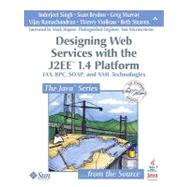
Foreword.
About the Authors.
Preface.
1. Introduction.
What Are Web Services?
Challenges of Web Service Development.
Typical Web Service Scenarios.
J2EE 14: The Platform for Web Services.
Conclusion.
2. Standards and Technologies.
Overview of Web Service Standards.
J2EE: The Integrated Platform for Web Services.
Other Java-XML Technologies.
Conclusion.
3. Service Endpoint Design.
Example Scenarios.
Flow of a Web Service Call.
Key Web Services Design Decisions.
Designing a Service's Interaction Layer.
Processing Layer Design.
Publishing a Web Service.
Handling XML Documents in a Web Service.
Deploying and Packaging a Service Endpoint.
Conclusion.
4. XML Processing.
XML Overview.
Outline for Handling XML Documents.
Designing XML-Based Applications.
Implementing XML-Based Applications.
Performance Considerations.
Conclusion.
5. Client Design.
Choosing a Communication Technology.
Scenarios for Web Services-Based Client Applications.
Developing Client Applications to Use a Web Service.
General Considerations.
Conclusion.
6. Enterprise Application Integration.
Integration Requirements and Scenarios.
J2EE Integration Technologies.
Integration Design Approaches.
Data Integration Guidelines.
Guidelines for Integration.
Conclusion.
7. Security.
Security Scenarios.
J2EE Platform Security Model.
Security for Web Service Interactions.
Message-Level Web Service Security.
Conclusion.
8. Application Architecture and Design.
Overview of Adventure Builder.
Order Processing Center Architecture and Design.
Endpoint Design Issues.
Web Service Communication Patterns.
Managing Complex Web Service Interactions.
Building More Robust Web Services.
Conclusion.
Glossary.
Index.
Foreword.
About the Authors.
Preface.
1. Introduction.
What Are Web Services?
Challenges of Web Service Development.
Typical Web Service Scenarios.
J2EE 14: The Platform for Web Services.
Conclusion.
2. Standards and Technologies.
Overview of Web Service Standards.
J2EE: The Integrated Platform for Web Services.
Other Java-XML Technologies.
Conclusion.
3. Service Endpoint Design.
Example Scenarios.
Flow of a Web Service Call.
Key Web Services Design Decisions.
Designing a Service's Interaction Layer.
Processing Layer Design.
Publishing a Web Service.
Handling XML Documents in a Web Service.
Deploying and Packaging a Service Endpoint.
Conclusion.
4. XML Processing.
XML Overview.
Outline for Handling XML Documents.
Designing XML-Based Applications.
Implementing XML-Based Applications.
Performance Considerations.
Conclusion.
5. Client Design.
Choosing a Communication Technology.
Scenarios for Web Services-Based Client Applications.
Developing Client Applications to Use a Web Service.
General Considerations.
Conclusion.
6. Enterprise Application Integration.
Integration Requirements and Scenarios.
J2EE Integration Technologies.
Integration Design Approaches.
Data Integration Guidelines.
Guidelines for Integration.
Conclusion.
7. Security.
Security Scenarios.
J2EE Platform Security Model.
Security for Web Service Interactions.
Message-Level Web Service Security.
Conclusion.
8. Application Architecture and Design.
Overview of Adventure Builder.
Order Processing Center Architecture and Design.
Endpoint Design Issues.
Web Service Communication Patterns.
Managing Complex Web Service Interactions.
Building More Robust Web Services.
Conclusion.
Glossary.
Index.
The New copy of this book will include any supplemental materials advertised. Please check the title of the book to determine if it should include any access cards, study guides, lab manuals, CDs, etc.
The Used, Rental and eBook copies of this book are not guaranteed to include any supplemental materials. Typically, only the book itself is included. This is true even if the title states it includes any access cards, study guides, lab manuals, CDs, etc.